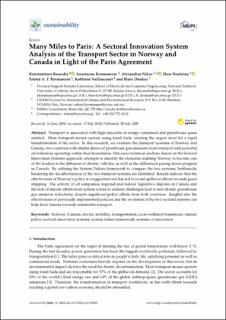| dc.contributor.author | Koasidis, Konstantinos | |
| dc.contributor.author | Karamaneas, Anastasios | |
| dc.contributor.author | Nikas, Alexandros | |
| dc.contributor.author | Neofytou, Hera | |
| dc.contributor.author | Hermansen, Erlend Andre T. | |
| dc.contributor.author | Vaillancourt, Kathleen | |
| dc.contributor.author | Doukas, Haris | |
| dc.date.accessioned | 2021-08-13T09:12:34Z | |
| dc.date.available | 2021-08-13T09:12:34Z | |
| dc.date.created | 2020-10-01T15:29:00Z | |
| dc.date.issued | 2020 | |
| dc.identifier.issn | 2071-1050 | |
| dc.identifier.uri | https://hdl.handle.net/11250/2767739 | |
| dc.description.abstract | Transport is associated with high amounts of energy consumed and greenhouse gases emitted. Most transport means operate using fossil fuels, creating the urgent need for a rapid transformation of the sector. In this research, we examine the transport systems of Norway and Canada, two countries with similar shares of greenhouse gas emissions from transport and powerful oil industries operating within their boundaries. Our socio-technical analysis, based on the Sectoral Innovation Systems approach, attempts to identify the elements enabling Norway to become one of the leaders in the diffusion of electric vehicles, as well as the differences pacing down progress in Canada. By utilising the System Failure framework to compare the two systems, bottlenecks hindering the decarbonisation of the two transport systems are identified. Results indicate that the effectiveness of Norway’s policy is exaggerated and has led to recent spillover effects towards green shipping. The activity of oil companies, regional and federal legislative disputes in Canada and the lack of sincere efforts from system actors to address challenges lead to non-drastic greenhouse gas emission reductions, despite significant policy efforts from both countries. Insights into the effectiveness of previously implemented policies and the evolution of the two sectoral systems can help draw lessons towards sustainable transport. | en_US |
| dc.language.iso | eng | en_US |
| dc.publisher | MDPI | en_US |
| dc.rights | Navngivelse 4.0 Internasjonal | * |
| dc.rights.uri | http://creativecommons.org/licenses/by/4.0/deed.no | * |
| dc.subject | Norway | en_US |
| dc.subject | Canada | en_US |
| dc.subject | electric mobility | en_US |
| dc.subject | transportation | en_US |
| dc.subject | socio-technical transitions | en_US |
| dc.subject | climate policy | en_US |
| dc.subject | sectoral innovation systems | en_US |
| dc.subject | system failure framework | en_US |
| dc.subject | systems of innovation | en_US |
| dc.title | Many Miles to Paris: A Sectoral Innovation System Analysis of the Transport Sector in Norway and Canada in Light of the Paris Agreement | en_US |
| dc.type | Journal article | en_US |
| dc.type | Peer reviewed | en_US |
| dc.description.version | publishedVersion | en_US |
| dc.source.volume | 2020 | en_US |
| dc.source.journal | Sustainability | en_US |
| dc.source.issue | 12 | en_US |
| dc.identifier.doi | 10.3390/su12145832 | |
| dc.identifier.cristin | 1836326 | |
| dc.relation.project | Norges forskningsråd: 268056 | en_US |
| dc.relation.project | EC/H2020/820846 | en_US |
| cristin.ispublished | true | |
| cristin.fulltext | original | |
| cristin.qualitycode | 1 | |

